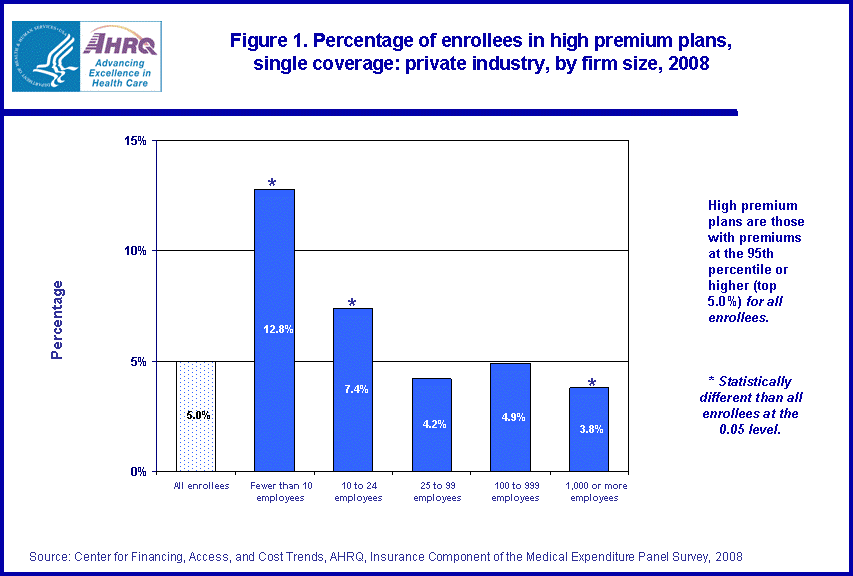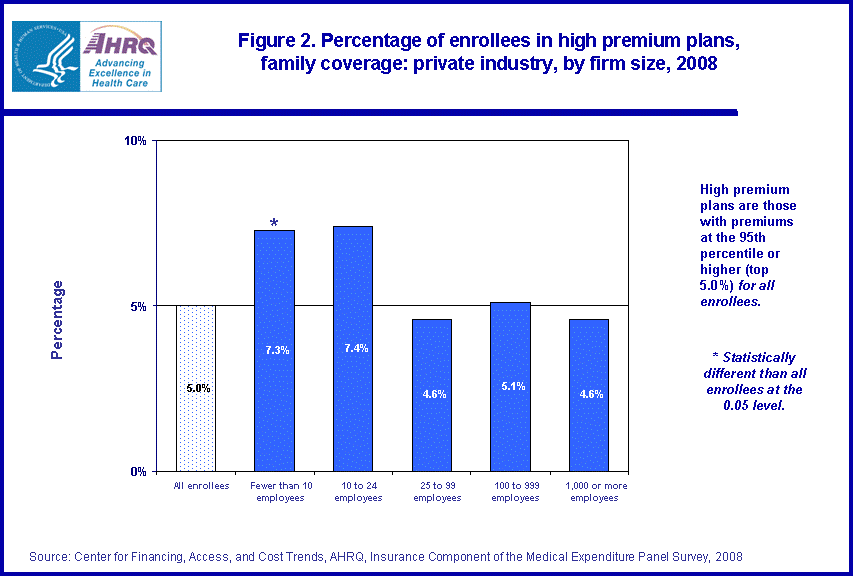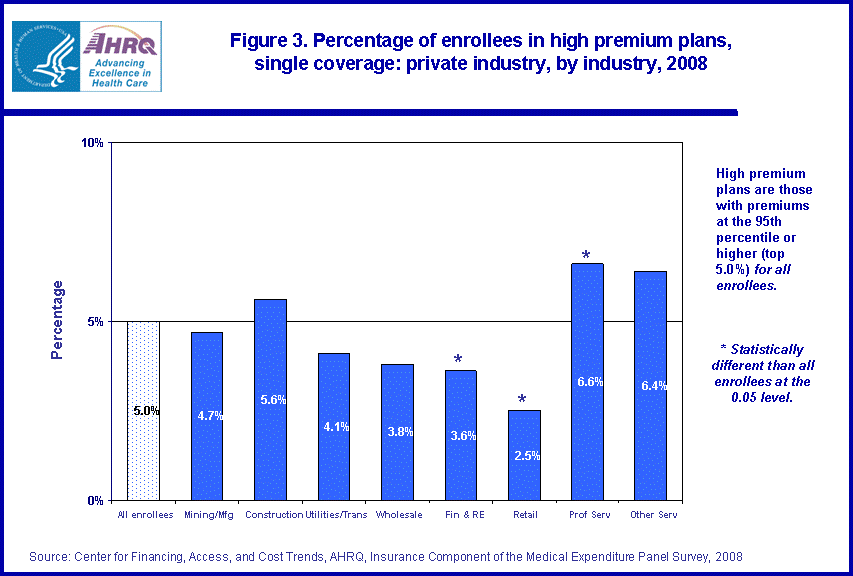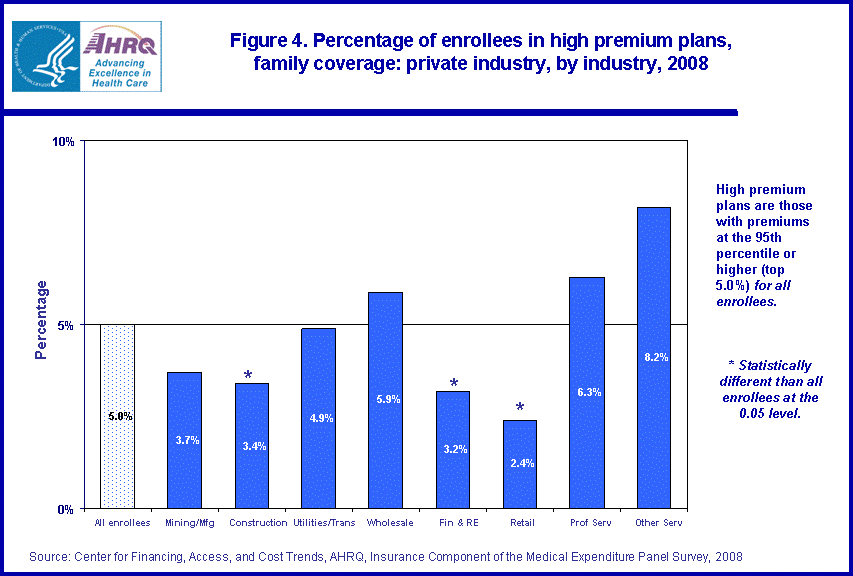
|
|
Font Size:
|
||||
|
|
|
|
||||
STATISTICAL BRIEF #283:
Enrollment in High Premium Employer-Sponsored Health Insurance, Private Industry, 2008
Highlights
- In 2008, employees in firms with less than 10 employees who were enrolled in employer-sponsored single and family coverage health insurance plans were more likely than average to have premiums equal to or greater than the 95th percentile ($7,200 and $19,000, respectively).
- Enrollees with single coverage in firms with 1,000 or more employees were less likely than average to have premiums equal to or greater than the 95th percentile of premiums.
- Enrollees working in the financial services and real estate sector and enrollees in the retail trade sector were less likely than average to have single and family employer-sponsored health insurance premiums equal to or greater than the 95th percentile.
Introduction
This Statistical Brief reports estimates on the percentage of private sector employees enrolled in employer-sponsored health insurance plans with high premiums, those with annual premiums equal to or greater than $7,200 for single coverage plans, and equal to or greater than $19,000 for family coverage plans. According to 2008 data from the Medical Expenditure Panel Survey-Insurance Component (MEPS-IC), these values represent the 95th percentile of private employer-sponsored health insurance premiums for single coverage and family coverage plans. That is, of all enrollees within each coverage type only five percent had premiums at or above these amounts. For single coverage, this was 1.6 million enrollees; for family coverage, this was 1.0 million enrollees (not including dependents covered under the plan) in 2008.
Estimates are discussed for the employer characteristics of firm size and industry. Other factors that can affect premiums include benefit packages that are more or less generous (through the absence or presence of deductibles and co-pays, for example) and demographic factors (such as age of enrollees or work schedule).
Note that results for employee-plus-one coverage are similar to those for family and single coverage. (See the Definitions section for detailed descriptions of the three coverage types.)
All estimates discussed in the text are significantly different from the overall 95th percentile estimates at the 0.05 level unless otherwise noted.
Findings
Figure 1 displays the percentage of single enrollees in employer-sponsored health plans with premiums equal to or greater than the 95 percentile of premiums by firm size, for the year 2008. The figure shows that 12.8 percent of enrollees in single coverage plans in firms with fewer than 10 employees, and 7.4 percent of enrollees with single coverage in firms with 10 to 24 employees had annual premiums equal to or greater than $7,200. In firms with a thousand or more employees, only 3.8 percent of enrollees with single coverage had premiums equal to or greater than $7,200.
Figure 2 shows the percentage of enrollees in employer-sponsored family plans with premiums equal to or greater than the 95th percentile by firm size. For family coverage, 7.3 percent of enrollees in firms with fewer than 10 employees had health insurance premiums equal or greater than $19,000. The percentage of family enrollees at other firm sizes in high premium plans did not differ from the overall average in 2008. Note that some percentages in each of the figures that appear to be different from the U.S. average of 5.0 percent--such as the 7.4 percent of enrollees with family coverage in firms with 10 to 24 employees in high premium plans--are not statistically different from 5.0 percent due to the size of the estimate's standard error.
The percentage of enrollees in high premium single coverage plans by industry for 2008 is shown in Figure 3. The professional services sector had 6.6 percent of enrollees in single coverage plans with premiums equal to or greater than $7,200. Both the financial services and real estate sector, and the retail trade sector had a lower than average percentage of enrollees in single enrollment plans with premiums equal or greater than $7,200; 3.6 percent and 2.5 percent respectively.
Figure 4 shows that in 2008 the results for the percentage of enrollees in high premium employer-sponsored family coverage plans by industry had some similarities to the findings for single coverage plans by industry. As seen for single plans, the financial services and real estate sector (3.2 percent), and the retail trade sector (2.4 percent) had lower percentages than average of enrollees in family plans with premiums equal to or greater than $19,000. For family coverage, construction also had a lower percentage, at 3.4 percent. No other industry's enrollment in high premium plans differed from the U.S. average.
Data Source
This Statistical Brief summarizes data from the 2008 MEPS-IC. The data are available on the MEPS Web site at http://www.meps.ahrq.gov/mepsweb/survey_comp/Insurance.jsp or have been produced using special computation runs on the confidential MEPS-IC data available at the U.S. Census Bureau.
Definitions
Health insurance plan
An insurance contract that provides hospital and/or physician coverage to an employee or retiree for an agreed-upon fee (premium) for a defined benefit period.
Firm
A business entity consisting of one or more business establishments under common ownership or control. A firm represents the entire organization, including the company headquarters and all divisions, subsidiaries, and branches. A firm may consist of a single-location establishment, in which case the establishment and firm are identical.
Premium
Agreed-upon fee paid for coverage of medical benefits for a defined benefit period, usually a calendar year.
Single coverage
Health insurance that covers the employee only.
Employee-plus-one coverage
Health insurance that covers the employee and one additional family member at a lower premium level than family coverage. This family member could be a spouse or a child. If premiums differed for employee-plus-spouse and employee-plus-child coverage, information for employee-plus-child was reported.
Family coverage
Health insurance that covers the employee and the employee's family. If a plan offered more than one pricing level for family coverage, information for a family of four was reported.
Industry
The classification by industry is based upon the North American Industrial Classification System; the Agriculture, Fishing, and Forestry sector is included in the U.S. totals, but is not shown separately in the figures:
- Mining/Mfg--Mining and Manufacturing
- Construction
- Utilities/Trans--Utilities and Transportation
- Wholesale--Wholesale Trade
- Fin & RE--Financial Services and Real Estate
- Retail--Retail Trade
- Prof Serv--Professional Services
- Other Serv--Other Services
About MEPS-IC
MEPS-IC is a survey of business establishments and governments that collects information on employer-sponsored health insurance, such as whether insurance is offered, enrollments, types of plans, and premiums. The survey is conducted annually by the U.S. Census Bureau under the sponsorship of the Agency for Healthcare Research and Quality. The yearly response rate has averaged 78 percent for in-scope sample units. Approximately 4 percent of the original sample has been out-of-scope in a typical year. A total sample of 42,000 private sector establishments was selected for the 2008 survey, prior to accounting for losses due to nonresponse and out-of-scope cases. For more information on this survey, see MEPS Methodology Reports 6, 8, 10, 14, 17, and 18 on the MEPS Web site at http://www.meps.ahrq.gov/mepsweb/data_stats/Pub_ProdLookup_Results.jsp?ProductType=Methodology%20Report&Comp=Insurance and Insurance Component Survey Basics at http://www.meps.ahrq.gov/mepsweb/survey_comp/Insurance.jsp.
Suggested Citation
Cooper, P. F, and Crimmel, B.L. Enrollment in High Premium Employer-Sponsored Health Insurance, Private Industry, 2008. Statistical Brief #283. June 2010. Agency for Healthcare Research and Quality, Rockville, MD. http://www.meps.ahrq.gov/mepsweb/data_files/publications/st283/stat283.shtml
AHRQ welcomes questions and comments from readers of this publication who are interested in obtaining more information about access, cost, use, financing, and quality of health care in the United States. We also invite you to tell us how you are using this Statistical Brief and other MEPS data and tools and to share suggestions on how MEPS products might be enhanced to further meet your needs. Please e-mail us at MEPSProjectDirector@ahrq.hhs.gov or send a letter to the address below:
Steven B. Cohen, PhD, Director
Center for Financing, Access, and Cost Trends
Agency for Healthcare Research and Quality
540 Gaither Road
Rockville, MD 20850
 |
||||||||||||||||||||||||||||||||||||
|
||||||||||||||||||||||||||||||||||||
|
|
||||||||||||||||||||||||||||||||||||
 |
||||||||||||||||||||||||||||||||||||
|
||||||||||||||||||||||||||||||||||||
|
|
||||||||||||||||||||||||||||||||||||
 |
||||||||||||||||||||||||||||||||||||
|
||||||||||||||||||||||||||||||||||||
|
|
||||||||||||||||||||||||||||||||||||
 |
||||||||||||||||||||||||||||||||||||
|
||||||||||||||||||||||||||||||||||||
|
|
||||||||||||||||||||||||||||||||||||


